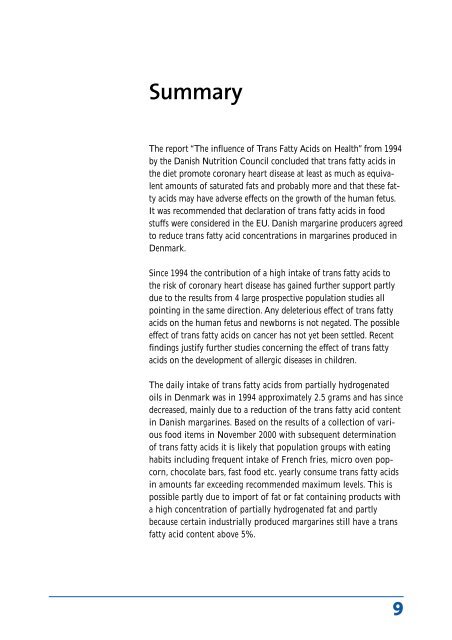Elektronisk udgave
Elektronisk udgave
Elektronisk udgave
Create successful ePaper yourself
Turn your PDF publications into a flip-book with our unique Google optimized e-Paper software.
Summary<br />
The report “The influence of Trans Fatty Acids on Health” from 1994<br />
by the Danish Nutrition Council concluded that trans fatty acids in<br />
the diet promote coronary heart disease at least as much as equivalent<br />
amounts of saturated fats and probably more and that these fatty<br />
acids may have adverse effects on the growth of the human fetus.<br />
It was recommended that declaration of trans fatty acids in food<br />
stuffs were considered in the EU. Danish margarine producers agreed<br />
to reduce trans fatty acid concentrations in margarines produced in<br />
Denmark.<br />
Since 1994 the contribution of a high intake of trans fatty acids to<br />
the risk of coronary heart disease has gained further support partly<br />
due to the results from 4 large prospective population studies all<br />
pointing in the same direction. Any deleterious effect of trans fatty<br />
acids on the human fetus and newborns is not negated. The possible<br />
effect of trans fatty acids on cancer has not yet been settled. Recent<br />
findings justify further studies concerning the effect of trans fatty<br />
acids on the development of allergic diseases in children.<br />
The daily intake of trans fatty acids from partially hydrogenated<br />
oils in Denmark was in 1994 approximately 2.5 grams and has since<br />
decreased, mainly due to a reduction of the trans fatty acid content<br />
in Danish margarines. Based on the results of a collection of various<br />
food items in November 2000 with subsequent determination<br />
of trans fatty acids it is likely that population groups with eating<br />
habits including frequent intake of French fries, micro oven popcorn,<br />
chocolate bars, fast food etc. yearly consume trans fatty acids<br />
in amounts far exceeding recommended maximum levels. This is<br />
possible partly due to import of fat or fat containing products with<br />
a high concentration of partially hydrogenated fat and partly<br />
because certain industrially produced margarines still have a trans<br />
fatty acid content above 5%.<br />
9

















